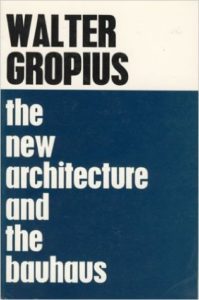 FROM THE VAULT: The New Architecture and the Bauhaus by Walter Gropius
FROM THE VAULT: The New Architecture and the Bauhaus by Walter Gropius
By Dr. Mark David Major, AICP, CNU-A, The Outlaw Urbanist contributor
The first 97 pages of The New Architecture and the Bauhaus (MIT Press with Foreword by Frank Pick) by Walter Gropius (published in 1965 but mostly written by Gropius earlier in 1923) is a virtuoso essay on the education of the architect in the modern era, which is must-read material for anyone interested about the educating of architects, urban designers and planners in today’s world. As is often the case with Modern architects, Gropius’ arguments begins to fall apart in a rather obvious way, in hindsight, over the last 12 pages when he attempts to extend his theories to the urban level. The less said about these last 12 pages, the better. Jane Jacobs in The Death and Life of Great American Cities has already – and better ably – tested the urban ideas of the International Style to destruction.
However, unlike many advocates of the International Style such as Le Corbusier, the writing of Gropius is clear, concise and easily understood in even layman terms; likely this is due to his German upbringing. In this book, Gropius spells out his ideas about architectural education within the context of the International Style’s preoccupation with industrialization and means of mass production. Nominally, these ideas are in reaction against the Beaux Arts academy model of architectural education during the 19th century. However, while spelling out his differences with the Beaux Arts in the promotion of the Bauhaus model, Gropius is also very careful to place the Bauhaus within the same, larger tradition of architectural education. This makes The New Architecture and the Bauhaus a very important book for the contemporary student/educator to better understand how our model of architectural education today also fits and complements the same tradition. This makes The New Architecture and the Bauhaus a richly rewarding read that is also easy to digest. The entire book can be read in one or two sittings.
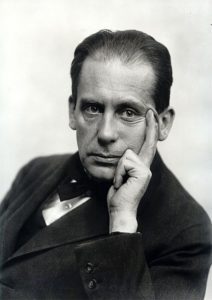 About Walter Gropius
About Walter Gropius
Walter Gropius, in full Walter Adolph Gropius (born May 18, 1883, Berlin, Germany and died July 5, 1969, Boston, Massachusetts, USA), was German American architect and educator who, particularly as director of the Bauhaus (1919–28), exerted a major influence on the development of modern architecture. His works, many executed in collaboration with other architects, included the school building and faculty housing at the Bauhaus (1925–26), the Harvard University Graduate Center, and the United State Embassy in Athens, Greece.
 The New Architecture and the Bauhaus
The New Architecture and the Bauhaus
by Walter Gropius with Foreword by Frank Pick
MIT Press Paperback, 112 pages
March 15, 1965
ISBN-10: 0262570068
ISBN-13: 978-0262570060
You can purchase The New Architecture and the Bauhaus by Walter Gropius from Amazon here.
From the Vault is a series from the Outlaw Urbanist in which we review art, architectural and urban design texts, with an emphasis on the obscure and forgotten, found in second-hand bookstores.


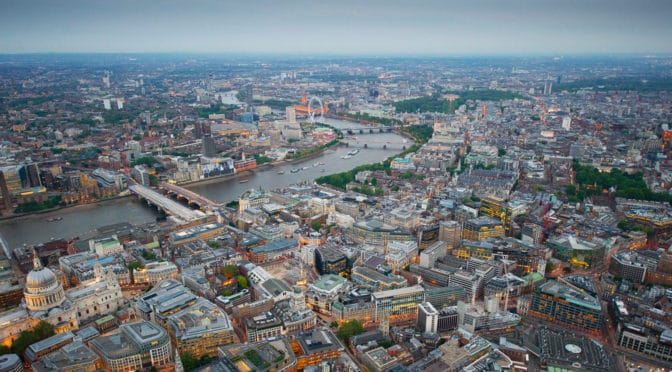
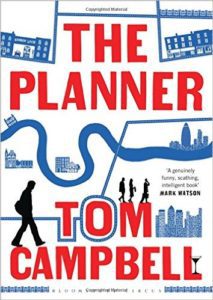
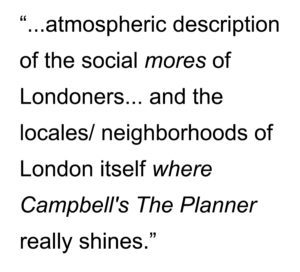 The personal revelations in The Planner are hardly surprising (people are not always as they appear) or earth-shattering (people are stupid and need to be told what to do, i.e. what one might expect from someone choosing town planning as a profession). This is especially true since it’s readily apparent this is the worldview James already holds at the start of the story, so acute self-awareness is the only lesson he learns on this journey. However, it is the atmospheric description of the social mores of Londoners (including lingering remnants of the class system) and the locales/neighborhoods of London itself where Campbell’s The Planner really shines. This includes all-too-familiar witty commentaries on the dreariness and inherently self-defeating proposition of the town planning profession itself in the absence of naked tyranny. Some of it is very cynical (e.g. everything is branding). You may not be entirely satisfied where The Planner ends up but you’ll enjoy the journey getting there, which so often describes what the city is really all about (3 1/2 stars out of 5).
The personal revelations in The Planner are hardly surprising (people are not always as they appear) or earth-shattering (people are stupid and need to be told what to do, i.e. what one might expect from someone choosing town planning as a profession). This is especially true since it’s readily apparent this is the worldview James already holds at the start of the story, so acute self-awareness is the only lesson he learns on this journey. However, it is the atmospheric description of the social mores of Londoners (including lingering remnants of the class system) and the locales/neighborhoods of London itself where Campbell’s The Planner really shines. This includes all-too-familiar witty commentaries on the dreariness and inherently self-defeating proposition of the town planning profession itself in the absence of naked tyranny. Some of it is very cynical (e.g. everything is branding). You may not be entirely satisfied where The Planner ends up but you’ll enjoy the journey getting there, which so often describes what the city is really all about (3 1/2 stars out of 5).

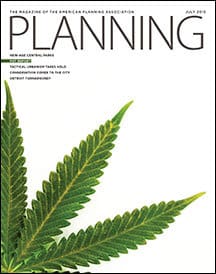 Planning Naked | July 2015
Planning Naked | July 2015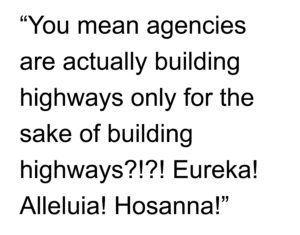 4. Lots of scare-mongering about the Koontz decision in this month’s “Legal Lessons” (pp. 9). However, the sidebar about “climate exactions” is interesting. I would like to see this tested out in the courts to see if any such ‘climate exaction’ could really bear the burden of legal scrutiny.
4. Lots of scare-mongering about the Koontz decision in this month’s “Legal Lessons” (pp. 9). However, the sidebar about “climate exactions” is interesting. I would like to see this tested out in the courts to see if any such ‘climate exaction’ could really bear the burden of legal scrutiny.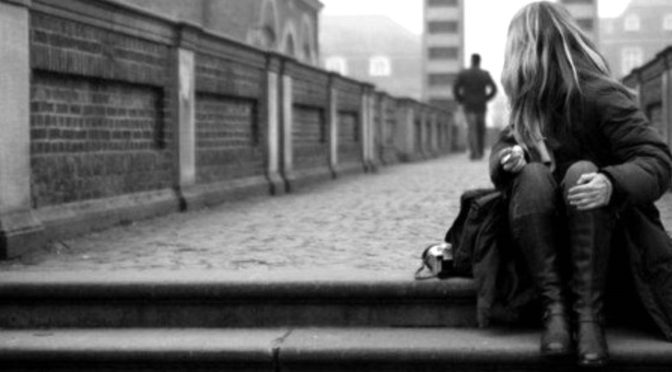
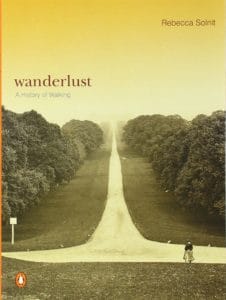
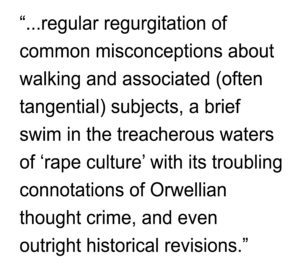 Herein lies the fatal flaw of the book. Soinit chooses to focus her history of walking on extraordinary events rather than ordinary, everyday occurrences (and their observation): this where the real richness about walking as a subject truly lies. It is unfortunate because, while Soinit’s focus is not always objective, she does, on occasion, provide keen observations about some subjects (a brief section on gyms near the end of the book is particular interesting). This unevenness makes Wanderlust: A History of Walking a real endurance test for the reader. There are some gems buried within the text but it is hard work along the path to find them. It will try and defeat most readers’ patience. I endured but I am unsure it was worth the effort.
Herein lies the fatal flaw of the book. Soinit chooses to focus her history of walking on extraordinary events rather than ordinary, everyday occurrences (and their observation): this where the real richness about walking as a subject truly lies. It is unfortunate because, while Soinit’s focus is not always objective, she does, on occasion, provide keen observations about some subjects (a brief section on gyms near the end of the book is particular interesting). This unevenness makes Wanderlust: A History of Walking a real endurance test for the reader. There are some gems buried within the text but it is hard work along the path to find them. It will try and defeat most readers’ patience. I endured but I am unsure it was worth the effort.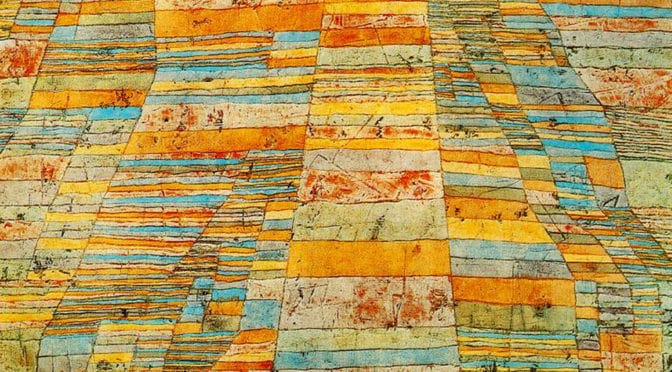
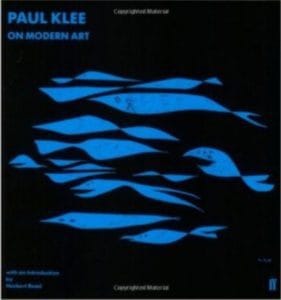
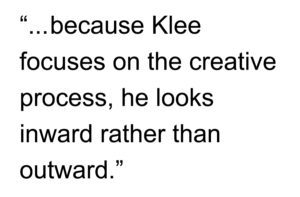 Because of this, Modern Art is not as rich with interesting observations, concepts and quotes that might find a common expression in architecture or urban planning (except perhaps its worst excesses, i.e. the architectural genius). Indeed, some of Klee’s text seems to pull back on his thoughts in
Because of this, Modern Art is not as rich with interesting observations, concepts and quotes that might find a common expression in architecture or urban planning (except perhaps its worst excesses, i.e. the architectural genius). Indeed, some of Klee’s text seems to pull back on his thoughts in